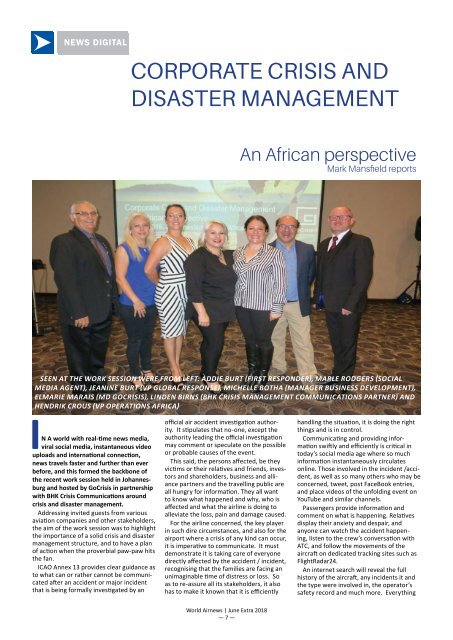World AirNews June 2018
- No tags were found...
Create successful ePaper yourself
Turn your PDF publications into a flip-book with our unique Google optimized e-Paper software.
NEWS DIGITAL<br />
CORPORATE CRISIS AND<br />
DISASTER MANAGEMENT<br />
An African perspective<br />
Mark Mansfield reports<br />
NEWS DIGITAL<br />
from page 6<br />
is swiftly laid bare and on public display.<br />
In addition to those directly involved, many others will<br />
comment and add to the conjecture and speculation, starting<br />
with the rescuers, and including the police, politicians and other<br />
authorities.<br />
To survive the crisis and protect its reputation, the affected<br />
airline or company cannot retreat into a foxhole and ‘not communicate’<br />
or hide behind the ICAO Annex 13 recommendation. In<br />
order to protect its reputation, an airline has to be ready, not only<br />
to properly manage the emergency, but also to adequately address<br />
the enormous crisis communication challenges.<br />
“Managing corporate crisis or the aftermath of a disaster involving<br />
victims, families, employees and a company’s brand is an<br />
overwhelming task in an environment where standards for a fast,<br />
effective, transparent and compassionate response are higher<br />
today than they have ever been”, said Elmarie Marais, Managing<br />
Director of GoCrisis as she opened the work session. “Crisis do happen,<br />
not a case of never, but when, people will forgive an accident<br />
but will not forgive a response”, continued Marais.<br />
Linden Birns emphasised the importance of a detailed crisis<br />
communication plan; “If you want communications on board for<br />
landing, they need to be on board for take off”. Birns went on to<br />
comment that facts were not determined by popular opinion, as<br />
could be the case when the wrong or false information was spread<br />
on social media platforms but must rather come from a reliable<br />
and credible source, hence the importance of a reputable Crisis<br />
and Disaster communications company.<br />
The session covered topics that ranged from airport and airline<br />
emergency preparedness, a case study presented by Linden Birns<br />
from BHK Crisis Communications around the challenges that are<br />
faced when dealing with multiple countries, governments, organisations,<br />
legal systems, cultures, and the ways of thinking and working<br />
and how pressures of online news and social media compound<br />
the challenger, to topics about cyber risk management. Q<br />
NEWS<br />
EMBRAER X<br />
UNVEILS FIRST<br />
eVTOL CONCEPT<br />
seen at the work session were from left: addie Burt (first responder), marle rodgers (social<br />
media agent), Jeanine Burt (Vp gloBal response), michelle Botha (manager Business deVelopment),<br />
elmarie marais (md gocrisis), linden Birns (Bhk crisis management communications partner) and<br />
hendrik crous (Vp operations africa)<br />
I<br />
N A world with real-time news media,<br />
viral social media, instantaneous video<br />
uploads and international connection,<br />
news travels faster and further than ever<br />
before, and this formed the backbone of<br />
the recent work session held in Johannesburg<br />
and hosted by GoCrisis in partnership<br />
with BHK Crisis Communications around<br />
crisis and disaster management.<br />
Addressing invited guests from various<br />
aviation companies and other stakeholders,<br />
the aim of the work session was to highlight<br />
the importance of a solid crisis and disaster<br />
management structure, and to have a plan<br />
of action when the proverbial paw-paw hits<br />
the fan.<br />
ICAO Annex 13 provides clear guidance as<br />
to what can or rather cannot be communicated<br />
after an accident or major incident<br />
that is being formally investigated by an<br />
official air accident investigation authority.<br />
It stipulates that no-one, except the<br />
authority leading the official investigation<br />
may comment or speculate on the possible<br />
or probable causes of the event.<br />
This said, the persons affected, be they<br />
victims or their relatives and friends, investors<br />
and shareholders, business and alliance<br />
partners and the travelling public are<br />
all hungry for information. They all want<br />
to know what happened and why, who is<br />
affected and what the airline is doing to<br />
alleviate the loss, pain and damage caused.<br />
For the airline concerned, the key player<br />
in such dire circumstances, and also for the<br />
airport where a crisis of any kind can occur,<br />
it is imperative to communicate. It must<br />
demonstrate it is taking care of everyone<br />
directly affected by the accident / incident,<br />
recognising that the families are facing an<br />
unimaginable time of distress or loss. So<br />
as to re-assure all its stakeholders, it also<br />
has to make it known that it is efficiently<br />
handling the situation, it is doing the right<br />
things and is in control.<br />
Communicating and providing information<br />
swiftly and efficiently is critical in<br />
today’s social media age where so much<br />
information instantaneously circulates<br />
online. Those involved in the incident /accident,<br />
as well as so many others who may be<br />
concerned, tweet, post FaceBook entries,<br />
and place videos of the unfolding event on<br />
YouTube and similar channels.<br />
Passengers provide information and<br />
comment on what is happening. Relatives<br />
display their anxiety and despair, and<br />
anyone can watch the accident happening,<br />
listen to the crew’s conversation with<br />
ATC, and follow the movements of the<br />
aircraft on dedicated tracking sites such as<br />
FlightRadar24.<br />
An internet search will reveal the full<br />
history of the aircraft, any incidents it and<br />
the type were involved in, the operator’s<br />
safety record and much more. Everything<br />
E<br />
MBRAER X, an Embraer organisation dedicated to developing<br />
disruptive businesses, has unveiled its first electrical<br />
Vertical Take-Off and Landing (eVTOL) aircraft concept.<br />
The unveiling was made during Uber Elevate <strong>2018</strong>, in Los Angeles,<br />
California. Embraer X is engaged in several projects, including<br />
the development of eVTOL concepts through a co-operation with<br />
Uber and other companies to explore business opportunities within<br />
the Uber Elevate ecosystem.<br />
“We have excelled in our near-50-year journey by introducing<br />
innovations into the aviation industry and delivering true value to<br />
customers,” said Paulo Cesar de Souza e Silva, President and CEO<br />
of Embraer. “We are relentless in our quest for constant growth<br />
and through Embraer X we will drive disruptive innovation and<br />
accelerate the creation of new businesses with the potential for exponential<br />
growth. Urban mobility is ripe for transformation and we<br />
are committed to having a major role in this key market.”<br />
The eVTOL concept presented at Uber Elevate <strong>2018</strong> represents<br />
an aircraft with a mission to serve passengers in an urban environment,<br />
based on the key design drivers of safety, passenger experience,<br />
affordability and a very low footprint for the community, in<br />
terms of noise and emissions.<br />
“We are developing solutions to bring on-demand air transportation<br />
to urban areas to improve quality of life for millions of people.<br />
Our collaboration with key stakeholders will accelerate the arrival<br />
of this new ecosystem,” said Antonio Campello, President & CEO<br />
of Embraer X. “This is one example of how Embraer X is committed<br />
to exploring a range of disruptive products and services that could<br />
revolutionize the business of air transportation.”<br />
Embraer X’s first eVTOL concept is the outcome of extensive<br />
interaction with potential urban air travellers about their desired<br />
experience, combined with the expertise of Embraer’s teams and<br />
the collaboration with various companies and institutions. Embraer<br />
X will continue to engage with communities to expedite the development<br />
of desired solutions for this new market.<br />
Over the last five decades, Embraer has designed, developed<br />
and certified close to 50 aircraft models, delivering over 8 000<br />
aircraft to 100 countries. Embraer’s fleet has accumulated more<br />
than 50-million flight hours. Leveraging Embraer’s experience and<br />
longstanding relationships with aircraft certification authorities<br />
around the globe, Embraer X will ensure that safety design drivers<br />
meet and exceed the highest industry standards.<br />
Embraer is a global company headquartered in Brazil with<br />
businesses in commercial and executive aviation, defence and security.<br />
The company designs, develops, manufactures and markets<br />
aircraft and systems, providing customer support and services.<br />
Since it was founded in 1969, Embraer has delivered more than<br />
8 000 aircraft. About every 10 seconds an aircraft manufactured<br />
by Embraer takes off somewhere in the world, transporting over<br />
145-million passengers a year.<br />
Embraer is claimed to be the leading manufacturer of commercial<br />
jets up to 150 seats. The company maintains industrial units,<br />
offices, service and parts distribution centres, among other activities,<br />
across the Americas, Africa, Asia and Europe. Q<br />
<strong>World</strong> Airnews | <strong>June</strong> Extra <strong>2018</strong><br />
— 7 —<br />
<strong>World</strong> Airnews | <strong>June</strong> Extra <strong>2018</strong><br />
— 8 —





